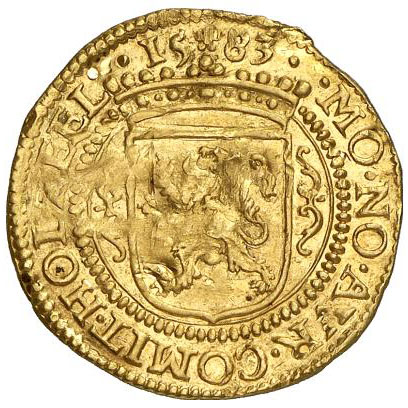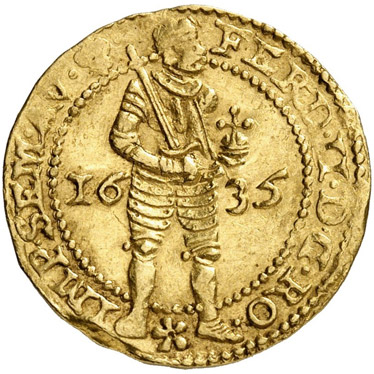Holland 1583 ducat
The first gold ducats minted in The Netherlands were not those of the Dutch type, which were those minted starting in 1586 with a knight holding a bunch of arrows on the obverse side and an inscription in a square on the reverse. Gold ducats were already being minted in 1583, but only a few copies of this type are known.

Holland 1583 ducat (Hungarian type)
(source: www.kuenker.de)
This extremely rare coin, the Holland 1583 ducat, was minted as a result of the resolution dated May 20, 1583. In this resolution new coin types were announced. One of them was the first gold ducat of the Hungarian type, minted in the Dordrecht mint (the official mint of the Holland province). The legends on these coins reads: Vigilate Deo Confidentes (translation: Watch Trusting In God) on the obverse, and MOneta NOva AVRea COMITate HOLlandiæ and ZEELandiæ (translation: The New Gold Coin of the County of Holland and Zeeland) on the reverse side. This type was only minted in 1583. Later on, the single ducats of the Hungarian type were minted in the Republic by several mints.
The importance of the Holland 1583 ducat is huge. This coin started an era of the standardization of a good, widely accepted and well-recognized worldwide gold coin for use in Dutch trade. Because payments in international trade required large amounts of money, gold coins – which were lighter and thus easier to store than large silver coins of a similar value – were needed. But gold coins minted in The Netherlands before 1583 had been issued in various weights and/or fineness, depending on the issuing authority. A large number of those were also debased coins. So a standardized gold coin was needed.
Efforts of the Holland province to mint the high quality coins and their fight against mints which were minting debased coins had already started before the establishment of the Republic of the United Netherlands. According to two agreements, the Pacification of Ghent, signed in 1576 and the Union of Utrecht signed in 1579, all provinces had agreed to work together, which included the minting of coins. From then on all the major decisions were supposed to be made by a group of representatives from all provinces (this group was called the States General). The agreements signed by representatives of the Gelderland, Holland (and West Friesland, as its sub-region), Zeeland, Utrecht and Friesland provinces.
On July 26, 1581, the States General signed in the Hague the Act of Abjuration (aka Declaration of the Independence of the Low Countries) and argued that the actions of King Phillip II of Spain had delegitimized his rule over the Low Countries. As one of the results of this act, from that point on showing the portrait, weapon, motto or even using the name of Philip II on coins was forbidden. In the 1580’s the States General unsuccessfully tried to limit the number of active mints in The Netherlands to keep control over the quality of coins being minted. They failed miserably, because their standardization was not met until 1694, when a number of the city mints in the Republic were closed.
Holland was always the province which demanded good and stable money for trade more than any of the other Dutch provinces. This was because Amsterdam, the largest city of this province was at that time the trade and business center of Europe. The Dutch ships loaded with gold ducats were traveling to the Baltic countries and to Asia, and used them for payments in exchange for the products demanded by merchants in The Netherlands. So they had to ensure only good money was being used.
Going back to the the coin from the photo, the selling price will also certainly help us to appreciate its importance. For the coin which was recently sold in the KĂ¼nker auction 171 in June 2010, the buyer had to pay $7,739. Expensive? Not so much. He was rather very lucky, because the same specimen had been sold previously in 2008 by AA-Muntveiling, a Dutch auction house, for $10,898.




